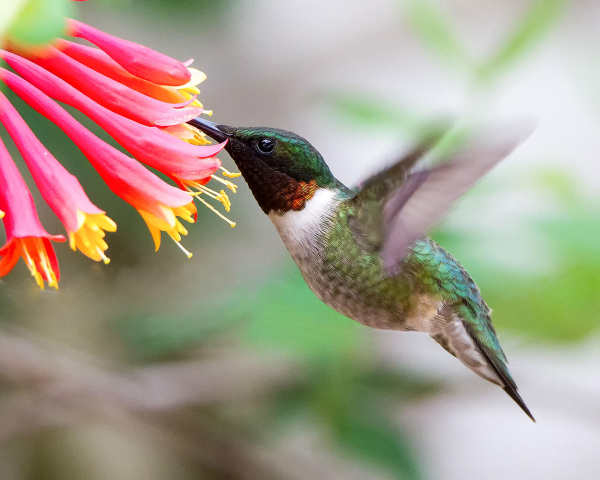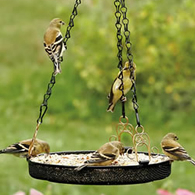
Hummingbirds can be regular backyard visitors during “winter months” in southern California, Louisiana, and even Florida (Ruby-throated Hummingbird photo by David Shipper).

Winter finches are a primary attraction at many feeding stations (Duncraft Mesh Platform Feeder).
|
Especially as the first signs of winter approach, a dramatic shift takes place across the middle of America, where a fairly distinct line can be drawn between many aspects of backyard birding to the north and to the south. The southern tier of states from Georgia to southern California offers a variety of different late fall and winter feeding station options that include providing hummingbird nectar and fruit in addition to seeds and suet – plus fresh water to satisfy the interests of resident, migrating, and wintering species.
It’s an exciting time to enjoy the mix of resident birds with new arrivals, as Anna’s Hummingbirds mix with White-crowned Sparrows in California, and Florida enjoys Northern Cardinals and Pine Siskins, with Texas inviting northern finches along with White-winged Doves and Green Jays. Certainly, the tier of states just north of the Sunbelt can also benefit from some of these feeding options as long as freezing temperatures don’t interfere.
Overall, late fall and winter feeding in the Sunbelt isn’t all that different from the rest of the year, even though you may get a few nights when there is a paper-thin layer of ice on your birdbath water. But the payoffs of taking your sugar-water feeder indoors at night and keeping some cut oranges and grape jelly available can be “fruitful,” especially if a new species or a rare off-course bird can be enticed to your feeding station.
Keep your hummingbird feeder active as much as possible; and we’d even suggest increasing the size of at least one of the feeding openings in your nectar feeder to attract other birds that may be interested in a sugar-water option. If you prefer, offer sugar-water in an oriole feeder for non-hummers.
Suet should be a standard at any feeding station, with no-melt suet a preferred option for many birders. There are a lot of different flavors and ingredients you can choose from among suet options, including seeds, berries, and more. Suet with chili pepper added is a favorite of birders who prefer to repel squirrels and other mammals that can dominate bird feeders – birds like it, squirrels don’t.
Thistle seeds, sometimes marketed as nyjer seeds, are the preferred food to attract migrant finches including siskins, although sunflower seed chips are just as attractive to these birds and a host of other seed-eating species. Aside from that, your regular seed mix will keep area birds coming, along with new arrivals, but you may want to consider some options – say a shell-less seed mix that eliminates the mess below your feeders.
Winter water is key to attracting late season warblers, or Yellow-rumped Warblers and others that may over-winter. Fresh water attracts a greater diversity of birds than any other element you can offer in your yard. A solar wiggler, solar mini-fountain, or a dripper might move water enough to keep it from freezing, and the sound of the moving water helps to attract new birds to your bird bath or another water feature.
Sunbelt Backyard Updates
It’s also a time when your landscaping efforts will pay off in a big way. For example, a Palm Bay, Florida birder attributes his giant 14 foot high and 10 foot wide flame bush and the bottle brush trees in his yard to improving the numbers of birds he sees at home. His yard list includes 130 species, including a new species last week – a Tennessee Warbler. He also noted that he was attracting 4 Ruby-throated Hummingbirds at once, plus migrants including such exciting birds as Cape May Warblers, Northern Parulas, and a Painted Bunting. Another Florida birder reported a rare western Rufous Hummingbird feeding at his honeysuckle blooms in the Tampa area.
Georgia birders are reporting Pine Siskins in many parts of the state, so get those thistle seeds out, along with sunflower seed chips. Mississippi birders reported the first Purple Finch of the season, along with Pine Siskins; and in Alabama siskins and juncos have landed too, with more northern species on the way.
Louisiana leads the way in the Southeast with 6 different species of hummingbirds being seen at nectar feeders, along with more native sparrows, juncos, and siskins arriving daily. Of course, Texas always has most of the wealth of wintering birds, resident species, and border crossing rarities from the south.
New Mexico birders can try to attract Scaled Quail along with a variety of doves and wintering native sparrows and juncos. Arizona has its share of hummingbirds with Costa’s and Anna’s most notable now; plus the chance of attracting ground doves, quail, a rare thrush, or sparrow species; and the feeder action gets more exciting the farther south you live.
Similar species can be expected in areas of southern California where Allen’s and Anna’s Hummingbirds abound, along with doves and California Quail. Plus the chance of Varied Thrushes and a variety of native sparrows, towhees, and wintering warblers makes backyard birding all the more exciting.
Whether you’re a Sunbelt resident or a “snowbird” who follows migrating birds south to a warmer winter clime for the winter months, enjoy the action during this exciting season when you never know what birds might grace your landscaping, water feature, and feeding options.
Share your backyard birding experiences and photos at editorstbw2@gmail.com